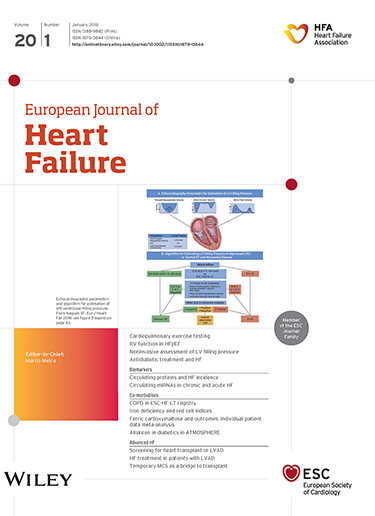Global patterns of polypharmacy after acute heart failure hospitalization: Prevalence and outcomes from the REPORT-HF registry.
IF 10.8
1区 医学
Q1 CARDIAC & CARDIOVASCULAR SYSTEMS
引用次数: 0
Abstract
AIMS Polypharmacy, defined as the concurrent use of ≥5 medications, is prevalent among older adults with heart failure (HF). While guideline-directed HF medications provide therapeutic benefits, non-HF polypharmacy, particularly involving inappropriate medications, may lead to adverse outcomes. The international REgistry to assess medical Practice with lOngitudinal obseRvation for Treatment of Heart Failure (REPORT-HF), the largest available global acute HF registry, was used to examine the prevalence, clinical correlates, and 1-year outcome associations of non-HF polypharmacy. METHODS AND RESULTS Medication counts were classified as no polypharmacy (<5), polypharmacy (5-9), and hyper-polypharmacy (≥10). Potentially harmful medications were identified using the 2016 American Heart Association scientific statement. Multivariable regression models examined correlates of polypharmacy and 1-year mortality. Among 18 030 patients (66 ± 14 years, 39% women), 39% had polypharmacy and 9% had hyper-polypharmacy (63% and 25%, respectively, if including HF medications). Non-HF polypharmacy was more common in older white patients from high-income countries, with preserved ejection fraction and high comorbidity burden. Patients with greater non-HF medication use were less likely to receive guideline-directed HF medications and more likely to take medications that can worsen HF. Crude hazard ratios (HRs) for 1-year mortality were 1.16 (95% confidence interval [CI] 1.08-1.25) for polypharmacy and 1.46 (95% CI 1.31-1.63) for hyper-polypharmacy versus no polypharmacy. After adjustment, hyper-polypharmacy remained associated with increased mortality (HR 1.16, 95% CI 1.01-1.33). CONCLUSIONS Non-HF polypharmacy in HF is common worldwide, particularly in high-income regions. Its association with reduced use of guideline-directed HF medications and higher usage of medications causing or worsening HF, as well as elevated 1-year mortality, underscores the importance of addressing polypharmacy in HF. CLINICAL TRIAL REGISTRATION ClinicalTrials.gov NCT02595814.急性心力衰竭住院后多重用药的全球模式:报告- hf登记的患病率和结果
AIMSPolypharmacy,定义为同时使用≥5种药物,在老年心力衰竭(HF)患者中普遍存在。虽然指南指导的心衰药物提供治疗益处,但非心衰多药治疗,特别是涉及不适当的药物治疗,可能导致不良后果。通过纵向观察评估心力衰竭治疗医疗实践的国际注册(REPORT-HF)是全球最大的急性心力衰竭注册,用于检查非心力衰竭多药的患病率、临床相关性和1年结局相关性。方法与结果用药计数分为无多药(<5)、多药(5-9)和超多药(≥10)。根据2016年美国心脏协会的科学声明,发现了可能有害的药物。多变量回归模型检验了多药与1年死亡率的相关性。18030例患者(66±14岁,39%为女性)中,39%为多药,9%为超多药(如果包括心衰药物,分别为63%和25%)。非心衰多重用药在高收入国家的老年白人患者中更为常见,他们的射血分数保持不变,合并症负担高。非心衰药物使用较多的患者较少接受指南指导的心衰药物治疗,更有可能服用可加重心衰的药物。综合用药组1年死亡率的粗风险比(hr)为1.16(95%可信区间[CI] 1.08-1.25),超综合用药组与非综合用药组的粗风险比为1.46 (95% CI 1.31-1.63)。调整后,过度多药仍与死亡率增加相关(HR 1.16, 95% CI 1.01-1.33)。结论非HF多药治疗在世界范围内普遍存在,特别是在高收入地区。它与指南指导的心衰药物使用减少、导致或加重心衰的药物使用增加以及1年死亡率升高有关,强调了解决心衰多药治疗的重要性。临床试验注册:clinicaltrials .gov NCT02595814。
本文章由计算机程序翻译,如有差异,请以英文原文为准。
求助全文
约1分钟内获得全文
求助全文
来源期刊

European Journal of Heart Failure
医学-心血管系统
CiteScore
27.30
自引率
11.50%
发文量
365
审稿时长
1 months
期刊介绍:
European Journal of Heart Failure is an international journal dedicated to advancing knowledge in the field of heart failure management. The journal publishes reviews and editorials aimed at improving understanding, prevention, investigation, and treatment of heart failure. It covers various disciplines such as molecular and cellular biology, pathology, physiology, electrophysiology, pharmacology, clinical sciences, social sciences, and population sciences. The journal welcomes submissions of manuscripts on basic, clinical, and population sciences, as well as original contributions on nursing, care of the elderly, primary care, health economics, and other related specialist fields. It is published monthly and has a readership that includes cardiologists, emergency room physicians, intensivists, internists, general physicians, cardiac nurses, diabetologists, epidemiologists, basic scientists focusing on cardiovascular research, and those working in rehabilitation. The journal is abstracted and indexed in various databases such as Academic Search, Embase, MEDLINE/PubMed, and Science Citation Index.
 求助内容:
求助内容: 应助结果提醒方式:
应助结果提醒方式:


